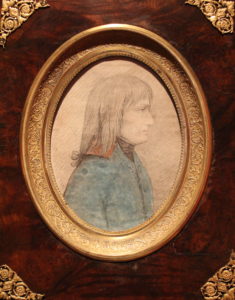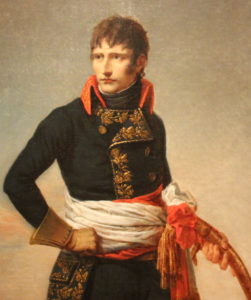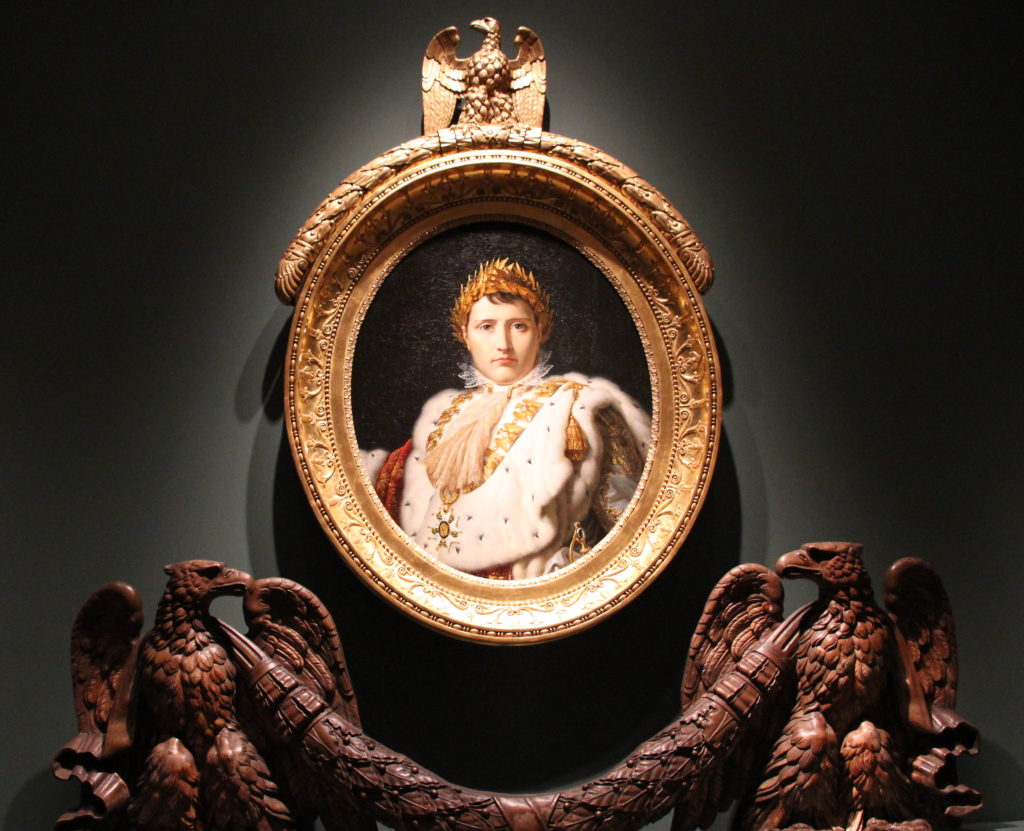Finding Napoleon in Virginia Again
The Napoleon Bonaparte exhibit at Richmond’s Museum of Fine Arts brought together exquisite artifacts, each fascinating in its own right. As a collection, they tell a visual story of Napoleon’s meteoric rise to power. Here are three pieces that touch on Napoleon Bonaparte’s early career:
Portrait of Napoleon Bonaparte as a Young Man in 1796
 After graduating in 1785 at age sixteen from the École Militaire (the French officers’ academy in Paris), Napoleon knocked around for almost eight years. He flitted between undistinguished military duties, returning home to Corsica on the pretext of ill-health, and flirting with Corsican revolutionaries while enforcing French rule as an officer in the occupation army. He managed to squeeze in a minor love affair.
After graduating in 1785 at age sixteen from the École Militaire (the French officers’ academy in Paris), Napoleon knocked around for almost eight years. He flitted between undistinguished military duties, returning home to Corsica on the pretext of ill-health, and flirting with Corsican revolutionaries while enforcing French rule as an officer in the occupation army. He managed to squeeze in a minor love affair.
Meanwhile, the French Revolution was in full swing. In 1793, age twenty-three, he made his first impression on French consciousness. Through clever artillery tactics, he routed the British Navy from Toulon, a French Royalist enclave. That year, the Revolution having cleared officer ranks of aristocrats, he was promoted to general. However, being Napoleon, he landed in prison where he narrowly escaped execution during the last throws of the Terror.
Back in Paris in 1795, he fell in love with Joséphine de Beauharnais, the mistress of his commanding officer, Paul Barras. The young general won the lady. Later that year, he was promoted to General of Division when he effectively (albeit brutally) put down a Royalist insurrection in the streets of Paris.
In 1796, he married Joséphine. Unfortunately for her fidelity, he immediately left France to command the Army of Italy. For the next two years, he won one stunning military victory after another. During that campaign, the artist Guiseppe Longhi produced this portrait of a rather unprepossessing young man.
Napoleon Bonaparte as First Consul
 After his victories in Italy and a brief stint being feted in Paris, in 1798, Napoleon embarked with an army of soldiers and scholars for Egypt. Apparently, he planned to conquer Egypt and continue to India, mimicking his hero Alexander the Great. But things really didn’t go his way in the Middle East.
After his victories in Italy and a brief stint being feted in Paris, in 1798, Napoleon embarked with an army of soldiers and scholars for Egypt. Apparently, he planned to conquer Egypt and continue to India, mimicking his hero Alexander the Great. But things really didn’t go his way in the Middle East.
Learning of a power vacuum in France (and that Joséphine was once again unfaithful), Napoleon sped back to Paris. There, he received a hero’s welcome (since the populace didn’t know the true state of affairs in Egypt). Immediately, he plunged into the political turmoil. In November 1799, he helped overthrow the failing French “Directory,” emerging as one of three Consuls chosen to lead a new government. He was, however, designated the First Consul, the only one with real power.
Andrea Appiani’s painting shows him in 1801, as “Napoleon Bonaparte, First Consul, in the Uniform of a General in the Army of Italy.” Here, he displays his new-found civil and military power with verve and style. How much he’s grown from that young, lank-haired officer portrayed in the first picture above.
Emperor Napoleon
From First Consul to Emperor of the French took four years. In that time, among other things, he defeated the Austrian Empire in his brilliant second Italian Campaign, fought off the British and the Russians, and sold Louisiana to the United States. He reconciled France with the Catholic Church, which the French Revolution had banned. On the home front, he pulled France out of financial collapse and wrote a new civil code (much of which is still in effect today). After national plebiscites, in May 1804, the senate declared him Emperor. On December 2, 1804, in Notre Dame cathedral, he crowned himself Emperor of the French.

In this oval portrait, Napoleon Bonaparte has transformed himself into an iconic, classical ruler whose dynasty will endure. On his head is a laurel leaf crown, a symbol of the ancients he admired. He also wears the ermines of the royalty he displaced, coupled with his own eagle and bee insignias. He combines symbols of the old order with his own new ones, a self-conscious melding of the Past and the Future. But what a change from the First Consul—a man of action—into this god-like king.
Not So Fast
So you see that Napoleon’s meteoric rise wasn’t “an overnight success.” Nineteen years passed between his graduation as an army officer until he placed an emperor’s crown on his head. The first eight were unremarkable. In fact, had he made his mark in the early years of France’s tumultuous revolution, he likely would have ended up at the guillotine. However, the next eleven years—starting in 1793 with the Battle of Toulon—is one of the most remarkable personal advancements in history.
